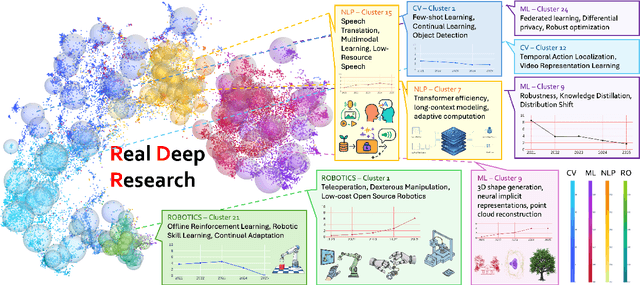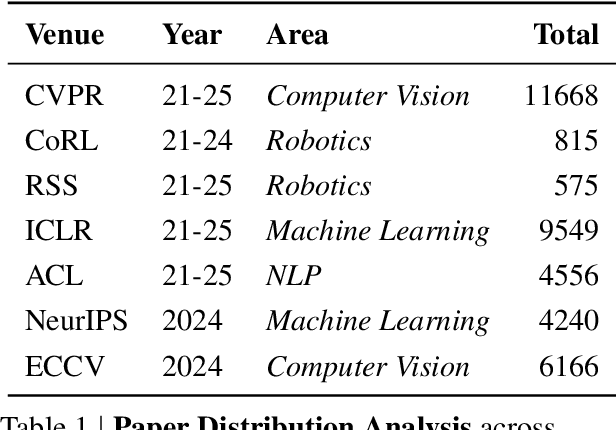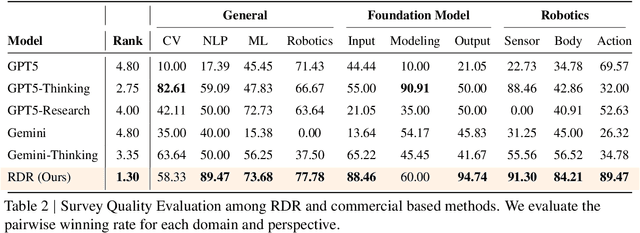Xiaolong Wang
Vrije Universiteit Amsterdam
Real Deep Research for AI, Robotics and Beyond
Oct 23, 2025



Abstract:With the rapid growth of research in AI and robotics now producing over 10,000 papers annually it has become increasingly difficult for researchers to stay up to date. Fast evolving trends, the rise of interdisciplinary work, and the need to explore domains beyond one's expertise all contribute to this challenge. To address these issues, we propose a generalizable pipeline capable of systematically analyzing any research area: identifying emerging trends, uncovering cross domain opportunities, and offering concrete starting points for new inquiry. In this work, we present Real Deep Research (RDR) a comprehensive framework applied to the domains of AI and robotics, with a particular focus on foundation models and robotics advancements. We also briefly extend our analysis to other areas of science. The main paper details the construction of the RDR pipeline, while the appendix provides extensive results across each analyzed topic. We hope this work sheds light for researchers working in the field of AI and beyond.
ARGenSeg: Image Segmentation with Autoregressive Image Generation Model
Oct 23, 2025Abstract:We propose a novel AutoRegressive Generation-based paradigm for image Segmentation (ARGenSeg), achieving multimodal understanding and pixel-level perception within a unified framework. Prior works integrating image segmentation into multimodal large language models (MLLMs) typically employ either boundary points representation or dedicated segmentation heads. These methods rely on discrete representations or semantic prompts fed into task-specific decoders, which limits the ability of the MLLM to capture fine-grained visual details. To address these challenges, we introduce a segmentation framework for MLLM based on image generation, which naturally produces dense masks for target objects. We leverage MLLM to output visual tokens and detokenize them into images using an universal VQ-VAE, making the segmentation fully dependent on the pixel-level understanding of the MLLM. To reduce inference latency, we employ a next-scale-prediction strategy to generate required visual tokens in parallel. Extensive experiments demonstrate that our method surpasses prior state-of-the-art approaches on multiple segmentation datasets with a remarkable boost in inference speed, while maintaining strong understanding capabilities.
GSWorld: Closed-Loop Photo-Realistic Simulation Suite for Robotic Manipulation
Oct 23, 2025Abstract:This paper presents GSWorld, a robust, photo-realistic simulator for robotics manipulation that combines 3D Gaussian Splatting with physics engines. Our framework advocates "closing the loop" of developing manipulation policies with reproducible evaluation of policies learned from real-robot data and sim2real policy training without using real robots. To enable photo-realistic rendering of diverse scenes, we propose a new asset format, which we term GSDF (Gaussian Scene Description File), that infuses Gaussian-on-Mesh representation with robot URDF and other objects. With a streamlined reconstruction pipeline, we curate a database of GSDF that contains 3 robot embodiments for single-arm and bimanual manipulation, as well as more than 40 objects. Combining GSDF with physics engines, we demonstrate several immediate interesting applications: (1) learning zero-shot sim2real pixel-to-action manipulation policy with photo-realistic rendering, (2) automated high-quality DAgger data collection for adapting policies to deployment environments, (3) reproducible benchmarking of real-robot manipulation policies in simulation, (4) simulation data collection by virtual teleoperation, and (5) zero-shot sim2real visual reinforcement learning. Website: https://3dgsworld.github.io/.
3D Aware Region Prompted Vision Language Model
Sep 16, 2025Abstract:We present Spatial Region 3D (SR-3D) aware vision-language model that connects single-view 2D images and multi-view 3D data through a shared visual token space. SR-3D supports flexible region prompting, allowing users to annotate regions with bounding boxes, segmentation masks on any frame, or directly in 3D, without the need for exhaustive multi-frame labeling. We achieve this by enriching 2D visual features with 3D positional embeddings, which allows the 3D model to draw upon strong 2D priors for more accurate spatial reasoning across frames, even when objects of interest do not co-occur within the same view. Extensive experiments on both general 2D vision language and specialized 3D spatial benchmarks demonstrate that SR-3D achieves state-of-the-art performance, underscoring its effectiveness for unifying 2D and 3D representation space on scene understanding. Moreover, we observe applicability to in-the-wild videos without sensory 3D inputs or ground-truth 3D annotations, where SR-3D accurately infers spatial relationships and metric measurements.
UR$^2$: Unify RAG and Reasoning through Reinforcement Learning
Aug 08, 2025Abstract:Large Language Models (LLMs) have shown remarkable capabilities through two complementary paradigms: Retrieval-Augmented Generation (RAG), which enhances knowledge grounding, and Reinforcement Learning from Verifiable Rewards (RLVR), which optimizes complex reasoning abilities. However, these two capabilities are often developed in isolation, and existing efforts to unify them remain narrow in scope-typically limited to open-domain QA with fixed retrieval settings and task-specific assumptions. This lack of integration constrains generalization and limits the applicability of RAG-RL methods to broader domains. To bridge this gap, we propose UR2 (Unified RAG and Reasoning), a general framework that unifies retrieval and reasoning through reinforcement learning. UR2 introduces two key contributions: a difficulty-aware curriculum training that selectively invokes retrieval only for challenging problems, and a hybrid knowledge access strategy combining domain-specific offline corpora with LLM-generated summaries. These components are designed to enable dynamic coordination between retrieval and reasoning, improving adaptability across a diverse range of tasks. Experiments across open-domain QA, MMLU-Pro, medical, and mathematical reasoning tasks demonstrate that UR2 (built on Qwen2.5-3/7B and LLaMA-3.1-8B) significantly outperforms existing RAG and RL methods, achieving comparable performance to GPT-4o-mini and GPT-4.1-mini on several benchmarks. We have released all code, models, and data at https://github.com/Tsinghua-dhy/UR2.
EgoVLA: Learning Vision-Language-Action Models from Egocentric Human Videos
Jul 16, 2025Abstract:Real robot data collection for imitation learning has led to significant advancements in robotic manipulation. However, the requirement for robot hardware in the process fundamentally constrains the scale of the data. In this paper, we explore training Vision-Language-Action (VLA) models using egocentric human videos. The benefit of using human videos is not only for their scale but more importantly for the richness of scenes and tasks. With a VLA trained on human video that predicts human wrist and hand actions, we can perform Inverse Kinematics and retargeting to convert the human actions to robot actions. We fine-tune the model using a few robot manipulation demonstrations to obtain the robot policy, namely EgoVLA. We propose a simulation benchmark called Isaac Humanoid Manipulation Benchmark, where we design diverse bimanual manipulation tasks with demonstrations. We fine-tune and evaluate EgoVLA with Isaac Humanoid Manipulation Benchmark and show significant improvements over baselines and ablate the importance of human data. Videos can be found on our website: https://rchalyang.github.io/EgoVLA
GMT: General Motion Tracking for Humanoid Whole-Body Control
Jun 17, 2025Abstract:The ability to track general whole-body motions in the real world is a useful way to build general-purpose humanoid robots. However, achieving this can be challenging due to the temporal and kinematic diversity of the motions, the policy's capability, and the difficulty of coordination of the upper and lower bodies. To address these issues, we propose GMT, a general and scalable motion-tracking framework that trains a single unified policy to enable humanoid robots to track diverse motions in the real world. GMT is built upon two core components: an Adaptive Sampling strategy and a Motion Mixture-of-Experts (MoE) architecture. The Adaptive Sampling automatically balances easy and difficult motions during training. The MoE ensures better specialization of different regions of the motion manifold. We show through extensive experiments in both simulation and the real world the effectiveness of GMT, achieving state-of-the-art performance across a broad spectrum of motions using a unified general policy. Videos and additional information can be found at https://gmt-humanoid.github.io.
Co-Design of Soft Gripper with Neural Physics
May 26, 2025Abstract:For robot manipulation, both the controller and end-effector design are crucial. Soft grippers are generalizable by deforming to different geometries, but designing such a gripper and finding its grasp pose remains challenging. In this paper, we propose a co-design framework that generates an optimized soft gripper's block-wise stiffness distribution and its grasping pose, using a neural physics model trained in simulation. We derived a uniform-pressure tendon model for a flexure-based soft finger, then generated a diverse dataset by randomizing both gripper pose and design parameters. A neural network is trained to approximate this forward simulation, yielding a fast, differentiable surrogate. We embed that surrogate in an end-to-end optimization loop to optimize the ideal stiffness configuration and best grasp pose. Finally, we 3D-print the optimized grippers of various stiffness by changing the structural parameters. We demonstrate that our co-designed grippers significantly outperform baseline designs in both simulation and hardware experiments.
Effective and Transparent RAG: Adaptive-Reward Reinforcement Learning for Decision Traceability
May 19, 2025Abstract:Retrieval-Augmented Generation (RAG) has significantly improved the performance of large language models (LLMs) on knowledge-intensive domains. However, although RAG achieved successes across distinct domains, there are still some unsolved challenges: 1) Effectiveness. Existing research mainly focuses on developing more powerful RAG retrievers, but how to enhance the generator's (LLM's) ability to utilize the retrieved information for reasoning and generation? 2) Transparency. Most RAG methods ignore which retrieved content actually contributes to the reasoning process, resulting in a lack of interpretability and visibility. To address this, we propose ARENA (Adaptive-Rewarded Evidence Navigation Agent), a transparent RAG generator framework trained via reinforcement learning (RL) with our proposed rewards. Based on the structured generation and adaptive reward calculation, our RL-based training enables the model to identify key evidence, perform structured reasoning, and generate answers with interpretable decision traces. Applied to Qwen2.5-7B-Instruct and Llama3.1-8B-Instruct, abundant experiments with various RAG baselines demonstrate that our model achieves 10-30% improvements on all multi-hop QA datasets, which is comparable with the SOTA Commercially-developed LLMs (e.g., OpenAI-o1, DeepSeek-R1). Further analyses show that ARENA has strong flexibility to be adopted on new datasets without extra training. Our models and codes are publicly released.
AMO: Adaptive Motion Optimization for Hyper-Dexterous Humanoid Whole-Body Control
May 06, 2025Abstract:Humanoid robots derive much of their dexterity from hyper-dexterous whole-body movements, enabling tasks that require a large operational workspace: such as picking objects off the ground. However, achieving these capabilities on real humanoids remains challenging due to their high degrees of freedom (DoF) and nonlinear dynamics. We propose Adaptive Motion Optimization (AMO), a framework that integrates sim-to-real reinforcement learning (RL) with trajectory optimization for real-time, adaptive whole-body control. To mitigate distribution bias in motion imitation RL, we construct a hybrid AMO dataset and train a network capable of robust, on-demand adaptation to potentially O.O.D. commands. We validate AMO in simulation and on a 29-DoF Unitree G1 humanoid robot, demonstrating superior stability and an expanded workspace compared to strong baselines. Finally, we show that AMO's consistent performance supports autonomous task execution via imitation learning, underscoring the system's versatility and robustness.
 Add to Chrome
Add to Chrome Add to Firefox
Add to Firefox Add to Edge
Add to Edge